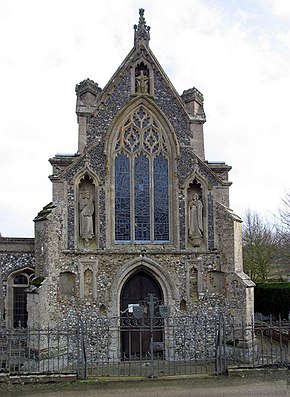Minor Basilica of Our Lady of Walsingham
| The Basilica of Our Lady of Walsingham The Slipper Chapel |
|
|---|---|
| Church of Saint Catherine of Alexandria | |

Frontal entrance of the shrine
|
|
| 52°52′52″N 0°51′12″E / 52.88112°N 0.85331°ECoordinates: 52°52′52″N 0°51′12″E / 52.88112°N 0.85331°E | |
| Location | Houghton Saint Giles |
| Country | England |
| Denomination | Roman Catholic |
| Website | Official website |
| History | |
| Founded | 1340 |
| Architecture | |
| Status | Active |
| Functional status | Shrine |
| Heritage designation | Grade I listed |
| Designated | 6 March 1959 |
| Architect(s) | Thomas Garner |
| Style | Gothic Romanesque |
| Administration | |
| Diocese | Diocese of East Anglia |
| Clergy | |
| Bishop(s) | Alan Hopes |
The Basilica of Our Lady of Walsingham, also known as the Slipper Chapel or the Chapel of Saint Catherine of Alexandria, is a Roman Catholic basilica located in Houghton Saint Giles, Norfolk, England. Built in 1340, it was the last chapel on the pilgrim route to Walsingham.
Pope Pius XII granted a canonical coronation to the venerated statue of the Blessed Virgin Mary under the title of Our Lady of Walsingham presently enshrined within the chapel on 15 August 1954.
Pope Francis raised the sanctuary to the status of a minor basilica via an apostolic decree on 27 December 2015.
When the Slipper Chapel was built, Walsingham was second only to Canterbury in the ranks of importance in English pilgrimage.
In 1538, after King Henry VIII's English Reformation, the chapel fell into disuse and was variously used as a poor house, a forge, a cowshed and a barn. In 1863, the chapel was identified by a wealthy local woman, Miss Charlotte Pearson Boyd (1837–1906), a convert to Catholicism from Anglicanism. She bought the building from the farm owner in 1896, restored it and then donated the chapel to Downside Abbey for Catholic use. On 6 February 1897, the chapel was re-established as a shrine authorising the image for public veneration by papal rescript from Pope Leo XIII. It was restored in 1904 by Thomas Garner.
...
Wikipedia

![The Basilica of Our Lady of Walsingham[1]The Slipper Chapel is located in Norfolk](http://upload.wikimedia.org/wikipedia/commons/thumb/5/5b/Norfolk_UK_location_map.svg/250px-Norfolk_UK_location_map.svg.png)